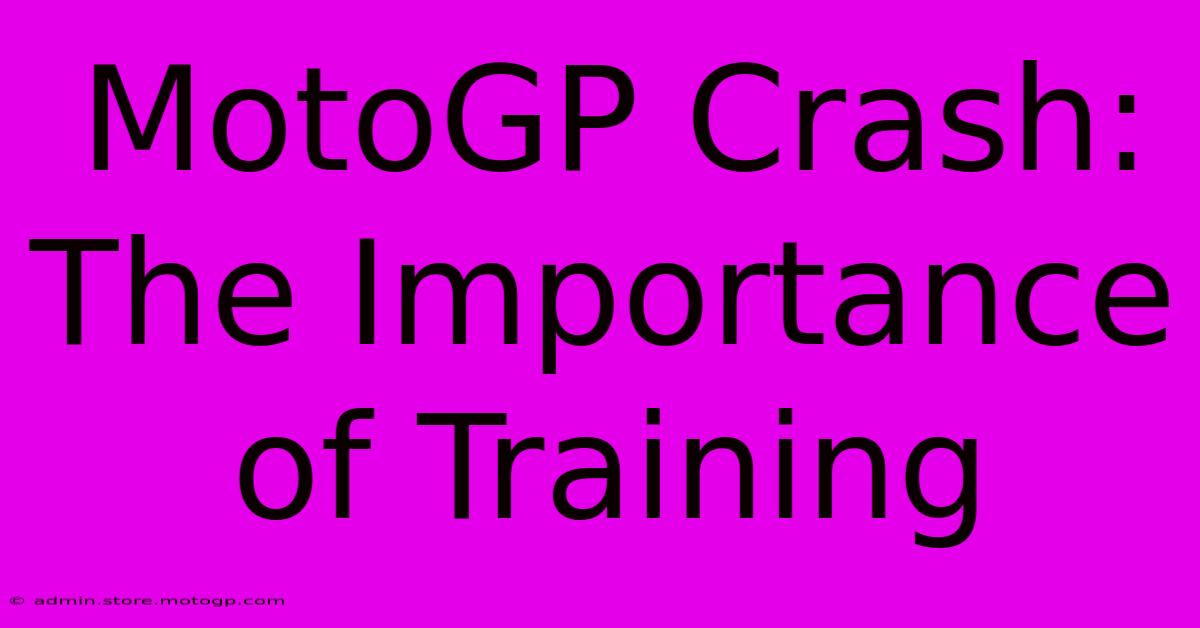MotoGP Crash: The Importance Of Training

Table of Contents
MotoGP Crash: The Importance of Training
The heart-stopping crashes we sometimes witness in MotoGP are a stark reminder of the immense physical and mental demands placed on these world-class athletes. While luck plays a role, the frequency and severity of crashes are often directly linked to rider preparedness. This isn't just about speed; it's about the rigorous training regime that separates survival from injury. This article delves into the crucial aspects of training that minimize risk and maximize rider performance in the high-stakes world of MotoGP.
The Physical Demands: More Than Just Strength
MotoGP riders aren't just fast; they're incredibly strong, agile, and resilient. The physical demands are extreme. Consider this:
- G-Forces: Riders endure immense G-forces during acceleration, braking, and cornering. This requires exceptional neck strength to prevent injury and maintain control. Specialized training focuses on strengthening neck muscles, often using resistance training and specific exercises.
- Endurance: A MotoGP race is a grueling test of endurance. Riders need exceptional cardiovascular fitness to maintain peak performance for the entire race duration, often exceeding 40 minutes. This requires extensive cardio training, including running, cycling, and specialized exercises that mimic the movements and demands of riding.
- Reaction Time and Reflexes: Split-second decisions can mean the difference between a clean pass and a devastating crash. Rigorous training focuses on honing reaction time and reflexes, often incorporating specialized simulator training and drills designed to improve cognitive function under pressure.
- Flexibility and Mobility: The contorted positions required for riding demand significant flexibility and mobility. Yoga, Pilates, and stretching exercises are crucial components of a MotoGP rider's training to prevent muscle strains and injuries.
Specialized Training Techniques for MotoGP Riders
Training isn't a one-size-fits-all approach. MotoGP riders employ a variety of specialized techniques, including:
- Strength and Conditioning: Weight training programs are meticulously designed to build strength and power while maintaining agility and flexibility.
- Motocross Training: Motocross riding helps develop crucial skills like bike control, body positioning, and reaction time in unpredictable off-road conditions.
- Ergonomics and Posture: Specialized training focuses on proper posture and body positioning on the bike to minimize strain and maximize control.
- Nutrition and Hydration: A well-structured diet and hydration plan is vital to fuel performance and aid recovery.
The Mental Game: Focus and Resilience
The mental aspects of MotoGP racing are equally important as the physical ones. High levels of focus, concentration, and mental resilience are crucial to perform under immense pressure.
- Mental Training: Techniques like visualization, meditation, and mindfulness are employed to enhance concentration and manage stress.
- Psychological Resilience: The ability to bounce back from setbacks, crashes, and mistakes is critical for consistent performance. Sports psychologists often work with riders to develop mental resilience and coping mechanisms.
- Strategic Thinking: Understanding race strategy, track conditions, and competitor tactics are vital for effective racing and minimizing risk.
Minimizing the Risk of Crashes Through Training
While crashes are inherent to motorsports, thorough training significantly reduces the likelihood of serious incidents. The benefits of rigorous training include:
- Improved Bike Control: Enhanced strength, reflexes, and reaction time translate directly into better bike control, reducing the risk of losing control in challenging situations.
- Enhanced Physical Fitness: Increased endurance and stamina prevent fatigue, which is a major contributing factor to crashes.
- Improved Decision-Making: Sharpened mental skills enable riders to make better decisions under pressure, avoiding risky maneuvers.
- Faster Reaction Time: Quicker reflexes allow riders to react to unexpected situations, minimizing the impact of incidents.
Conclusion:
The intense physical and mental preparation undertaken by MotoGP riders is not merely about achieving victory; it's about minimizing risk and ensuring their safety. The dedication to training is a testament to the extreme demands of this sport and highlights the crucial role of preparation in preventing crashes and promoting rider well-being. The dedication to training is far more than just physical; it's a holistic approach encompassing physical, mental, and strategic preparation, all working together to create a safer and more successful racing experience.

Thank you for visiting our website wich cover about MotoGP Crash: The Importance Of Training. We hope the information provided has been useful to you. Feel free to contact us if you have any questions or need further assistance. See you next time and dont miss to bookmark.
Featured Posts
-
The Future Of Moto2 2025 Standings Predictions
Feb 18, 2025
-
Moto Gp Arcade Get In The Race
Feb 18, 2025
-
Lot F Cota Cutting Edge Technology
Feb 18, 2025
-
Moto Gp Sprint Race Results Whos Leading The Pack
Feb 18, 2025
-
Cota Parking Dont Get Lost
Feb 18, 2025
